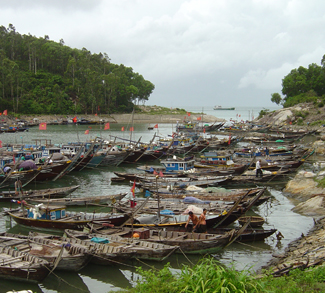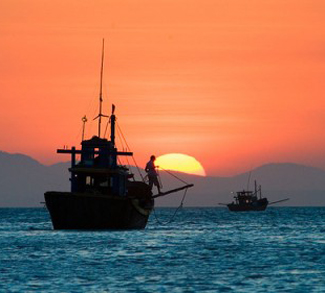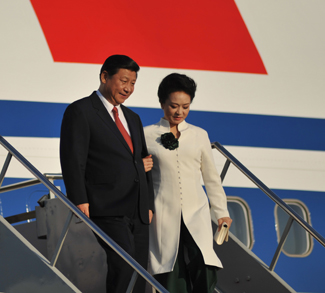The sky is now an azure blue and the wind so tame it barely wrinkles the surface of the quiet harbor. Dr. Chu Manh Trinh, a marine biologist, along with some of his graduate students from DaNang University, are standing at the clean and well-swept dock, along with neatly stacked recycled trash bags, at Cu Lao Cham, located about 20 kilometers off Vietnam’s central coast.
In the surrounding harbor, there’s a patina of living corals; jewels of the sea that offer an iridescent combination of blue, pink, golden-yellow, and green coloration. Here the residents know that their corals reveal many stories. Science reminds reminds us all too often, that corals are the canaries of climate change and indeed they face death from many threats.
The 2,3000 islanders are harmoniously connected to their East Sea. The fishers, some in their small wooden trawlers and many in the traditional round woven basket boats or “thung chai” cast their nets and lines for abalone, sea bass, grouper, lobster, squid, and sea cucumber. Their home of more than 1,500 hectares of natural forest houses a critical ecosystem that includes coral reefs, seaweed, and sea grass beds. It’s not surprising that in the 1960s, the island was referred to as “Paradise Island.”
The South China Sea is widely regarded as a potential flashpoint in the world. With its intractable sovereignty clams, threats to fishermen, exploitation of fish, coral reef destruction, biodiversity, and ecological imbalances, it was most reassuring to travel to an uncontested and peaceful island in the East Sea where traditional fishermen have adopted an ocean ethic as evidenced in their daily conservation and sustainable practices.
“When I first proposed my idea that they needed to stop fishing near the coral reefs, they thought I was crazy,” exclaimed marine biologist Dr. Chu Manh Trinh, flashing his high-voltage smile.

Dr. Trinh with his students, credit: James Borton
For these Vietnamese, the abundance of local marine life is evident from the crabs, seaweeds, mussels, snails and the essential small coral polyps resembling overturned jellyfish that absorb the excess carbon dioxide in the sea and transform it into limestone.
The Cham Islands is a marine protected area (MPA) that was established by the Provincial People’s Committee of Quang Nam Province in December 2005. Trinh, a 53-year-old Da Nang University biology professor, is largely responsible for mapping out the agreed upon objectives of protecting natural resources, and cultural and historical values of the Cham archipelago. In 2009, the area was designated a World Biosphere Reserve by UNESCO.
“Yes, it took a sustained educational campaign to convince the population that conservation would provide long-term benefits to their way of life,” claims Trinh.
In a stroll about the community, Trinh is happily greeted as the “professor” by fishers mending nets, by women in the common open-air market, and by the military personnel stationed on the island. The energetic marine scientist expresses quiet pride in the way these residents have embraced a sustainable model for fishing that has yielded a new economy from ancillary revenue streams created by dive groups, home stays, local tour guides, fish sauce and even forest tea product processing.
Cham, a 300 square-kilometer archipelago is also referred to as “Me Lao Cham” (Mother of Cham Island). It boasts a 518-meter high mountain with three peaks (Ngoc Long, Tien But and Bat Lao), formerly the home of the ancient king of Cham Pa. The region has both large and small islands, including: Hon La, Hon Kho, Hon Dai, Hon Man, Hon Lon, Hon Loi and Hon En, all scattered across the East Sea. Hon En (Island of Bird’s Nest) is an island where a swallow’s nest industry is one of the main work activities of the local people, producing hundreds of tons of bird’s nests bound for Hoi An annually.
This fishing village is not removed from the international spotlight sharply focused on atolls and islands amidst the roiling political waves of the Spratlys and Paracel islands. In these troubled waters, the island’s fishermen find themselves connected with an unwanted predicament: a geopolitical conflict that often prevents them from making their livings effectively.
There’s a myriad of challenges here, including China’s construction of artificial islands, coral destruction, the placement of a mega size oil rig in disputed waters, the ramming and sinking of traditional wooden fishing boats, false references of historic rights, and imposed fishing moratoriums.
Of course, the situation in the Spratly islands offers many complications. The more than 700 islands and reefs have been claimed by six countries – China, Malaysia, Vietnam, Philippines, Brunei and Taiwan – for more than thirty years and for different reasons. However, what’s clear is that the maritime control of the South China Sea has a dual dramatic impact on freedom of navigation and on the pursuit of resources.
Nevertheless, it does not help science cooperation in the region, when the president of the National Institute for South China Sea Studies, Dr. Wu Shicun states that “strict ecological protection measures are guiding the construction China is carrying out on the reefs.” In an effort to assuage environmental concerns, he adds, that the construction was on reefs that “are already dead.”
Dr. Nguyen Chu Hoi, senior lecturer at Vietnam National University and former Deputy General Director of the Vietnam Sea and Islands Agency, knows that the blue benefits provided by the sea are only possible by maintaining healthy coastal and marine ecosystems. He understands that “these environments are critical to sustaining social and economic development in the ASEAN region, as well as to protecting globally significant ecological service values and resources for the world.”
Environmental policy seems to be a tool that the Communist Party is using to shape both a blue economy future and eco-tourism. Just as Ho Chi Minh, the nation’s most well-known revolutionary leader, once remarked, “Forests are gold; if we know how to protect and develop them well, they will be very precious.” He could have easily transposed the term forests to the East Sea. Perhaps, the crucible of the ongoing degradation of the environment, among all claimants in the contested sea, is bringing about an unexpected interaction between citizens, ideas, and objects, namely fish and their rapid decline.
Vietnam and China have a complex relationship going back more than 2,000 years, including several periods of Chinese imperial occupation that were ended by Vietnamese uprisings. In the troubled South China Sea, hostilities spilled over the Johnson South Reef in 1988, when Chinese soldiers killed over seventy Vietnamese solders, and China raised its flag over the barren rock.
In Vietnam, the roughly 160,000 members of the Cham ethnic minority, whose forebears dominated the South China Sea for more than a millennium, are now quietly on the sidelines of the escalating conflict over fishing waters and sovereignty claims.
Today the Cham remain wary of engaging in such disputes, the present territorial wrangling only serves as a reminder of the symbolic and economic importance of their East Sea and of the Cham culture that was once enriched by trade across it.
The Cham’s vast trade network extended northeast to China, Taiwan, and Japan and south to Malaysia and Indonesia. Today, the Cham and the Kinh, have witnessed China’s oceanic plundering, coastal pollution associated with industrialization, and the destruction of more coral reefs.
According to Trinh, the residents now on the protected island are no longer Cham but are Kinh people, the majority ethnic group of Vietnam. There were nearly 5,000 people living in this Eden-like setting before 1975, mainly from the mainland districts of Hoi An with many fleeing the war and finding boat passage to Cu Lao Cham.
“After the American war more than half of the residents returned home,” claims Trinh. The population never increased because the young people are seeking jobs and opportunities on the mainland.
Vietnam has adopted marine protected areas to address present and future food security issues. Since the 1960s, the number of fish species in the South China Sea has markedly declined from 487 to 238. So Vietnam’s marine scientists like Professor Trinh, joined by Dr. Nguyen Chu Hoi and Dr. Vo Si Tuan, are in full agreement that stewardship of the ocean is an essential life force for the future of their nation and the region.
Vietnam’s S-shaped coastline stretches 3,200 kilometers, excluding islands and encompasses a total coral reef area of 1,270 kilometers. Hanoi’s political leadership recognizes what has long been acknowledged that coral reef conditions are under assault and declining. For that matter, the corals of the entire South China Sea cover an area of 30,000 square kilometers and provide a livelihood for hundreds of thousands of fishers.
It’s noteworthy that in June 1985, Vietnam adopted a National Conservation Strategy as a key component of an overall plan for national survival. It emphasizes the need to reduce human population growth, and to increase forest cover to ensure improved soil and water conservation. The original protected areas system was designed almost exclusively to protect upland forest, and largely ignored marine, coastal, wetland, and lowland forest environments.
Vietnam now finds itself at a difficult crossroads between economic development that will bring prosperity to its people and conservation initiatives that maintain the rich beauty and natural heritage of the country. What is encouraging is that the local provinces along with Hanoi are listening to the scientists and willing to adopt their conservation and sustainability new initiatives that partner NGOs, local government, and private businesses – all working in concert towards a more sustainable future.
Since 2010, Vietnam has embarked on an ambitious initiative to create “national marine protected areas.” As a result, the country currently has eight of these areas established with plans to add eight more in the near future or by 2020. The goal is that this state-led environmentalism will create a transformative mindset among the nation’s younger citizens and their relationship to the sea.
Vietnam’s rapid development from one of the five poorest countries in the world in 1985 to one of the world’s fastest growing economies has had dramatic environmental consequences: rivers dying from industrial pollution, biodiversity loss, and increasing air quality issues in not only Ho Chi Minh City but also Hanoi. As a result, more young social media inspired youth are forming organizations like “Be the Change Agents” to build support for a cleaner environment.
Cu Lao Cham’s MPA has over 277 coral species, 270 reef fish species, four lobster species and 97 types of mollusks. While not as significant in marine biodiversity as the Great Barrier Reef or the Coral Triangle in the South China Sea, it appears to be recognized as an excellent eco-tourism model without any of the typical and associated problems of pollution: increased rate of exploitation, untreated sewage, harvesting of coral for use in construction, the aquarium and shell trades, careless use by tourists and, more generally, increasing population density on the island.
Some marine scientists would quickly add that there are obstacles to creation of MPAs, including, rapid economic development, a growing population with low environmental awareness, financial constraints on government budgets, and opposition from people who fear the loss of livelihood, limited socioeconomic data, and at times an unresponsive and poorly trained bureaucracy.
“Protecting ecosystems, sharing natural resources and diversifying livelihoods are key to strengthening the Cham Island communities,” Trinh added, as we stopped at the island’s museum to examine village artifacts on display.
This marine protected model offers scientific evidence to encourage even China to rethink its diplomatic strategy and to move away from its previous “development first, treat pollution later” economic path. In fact, many observers believe that the timing is excellent for a shared sense of urgency associated with the unabated marine resource demands and coral reef destruction. Perhaps Vietnam’s renewed attention to conservation, sustainability, and environmental rule may succeed in challenging China to embrace a distinctive environmental diplomacy.
Meanwhile on this peaceful island, overnight visitors are offered home stay accommodations as guests of Mrs. Nguyen Thi Van and other local residents. Each morning either roosters or the community-wide public speakers serve as the early wake-up call. The island receives its news and announcements from the Commune, Hoi An, and Quang Nam Province. This includes the all-important daily weather forecast and a general reinforcement of conservation and sustainability objectives, like “no plastic on the island” and “keep the streets and pathways clean.”
Never mind, that there are other successes like the Nha Trang Bay Marine Protected Area (MPA). It is the first comprehensively developed and managed MPA in Vietnam. Vietnam’s MPAs are administered and managed at the national level, through the National Marine Park Authority. There are 36 Marine Protected Areas in Vietnam, four of which are predominantly coral reef MPAs, the majority of them having been established more than two decades ago.
Nguyen Toan Hoang, a 57 year-old fisherman who was born on the island, described his new way of life in the company of other veteran fishers on Cham:
“Sure the fishing is still good, in fact, its improved, but we are happy to make our living from running dive shops and even home stays these days because of our marine protected area.”
James Borton is an ocean steward and a Faculty Associate at the Walker Institute at the University of South Carolina. He edited The South China Sea: Challenges and Promises.




